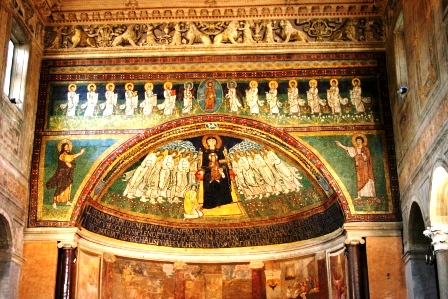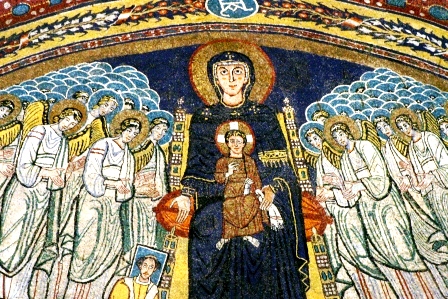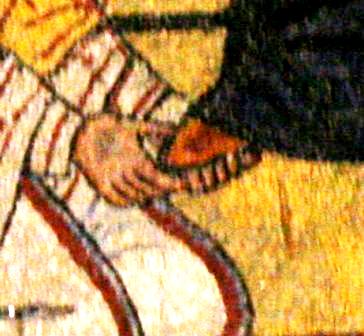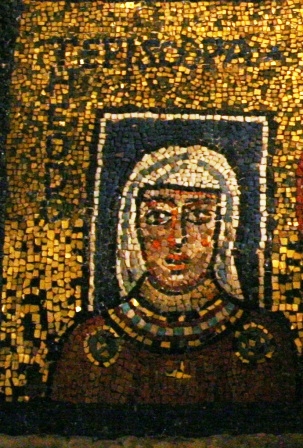Surely you have noticed that there is sometimes a scramble in the blogosphere for people to post entries about pretty much the saaame topics. I do it too, I know, but I usually try to do sometimes a bit different.
Today, 2nd Sunday of Lent, other bloggers (for example) have posted on the Roman Station church, Santa Maria in Domnica, on the Caelian Hill (one of the seven Rome is famous for). Those other excellent efforts notwithstanding, here are a couple photos of the finest mosaics in Rome in the apse of the basilica. These were done at the time of Pope Pascal (+824).
The Apse:

A Detail:

 You can see the humble little Paschal himself kneeling by Mary’s feet, his tilted square halo telling us that he was alive when the mosaics were executed. The mosaic reveals that a transition was going on in making of mosaics. Even though there are still lot’s of Greek elements here (Paschal harbored lots of Greek refugees in Rome who did some of the work – even without a Pontifical Council for Migrants and Itinerate Workers), in depicting Mary there was a shift away from the Byzantine to more of a Roman style. Here the Mother of God is shown not so much as a Byzantine empress but as more of a Roman matron. The little Paschal is really very sweet. He is kneeling and holding on to her foot as a sign of his loyalty to her. (Just a little fuzzy, sorry).
You can see the humble little Paschal himself kneeling by Mary’s feet, his tilted square halo telling us that he was alive when the mosaics were executed. The mosaic reveals that a transition was going on in making of mosaics. Even though there are still lot’s of Greek elements here (Paschal harbored lots of Greek refugees in Rome who did some of the work – even without a Pontifical Council for Migrants and Itinerate Workers), in depicting Mary there was a shift away from the Byzantine to more of a Roman style. Here the Mother of God is shown not so much as a Byzantine empress but as more of a Roman matron. The little Paschal is really very sweet. He is kneeling and holding on to her foot as a sign of his loyalty to her. (Just a little fuzzy, sorry).
Paschal was quite the restorer of things and did a lot of work on the Caelian. He also rebuilt Santa Caecilia in the Trastevere district and S. Prassede on the Esquiline. It is at Santa Prassede that in the little St. Zeno Chapel you see the now infamous mosaic depiction of Paschal’s  mom, Teodora. In the mosaic she sports the title "episcopa" because she was the Bishop of Rome’s mother and for no other reason than that.
mom, Teodora. In the mosaic she sports the title "episcopa" because she was the Bishop of Rome’s mother and for no other reason than that.
It was a commonplace in the ancient world to extend titles borne by one person to members of their immediate family. This would be like calling the former President, "Senator Clinton". (Figure that out. But you get my drift.)
The real story is that Paschal, who built that chapel in St. Praxidis, really loved his mom and so he honored her with a portrait for her perpetual memory and gave her his own title so people would know which Teodora they were looking at.
That is the whole skinny on the Theodora mosaic. One suspects that she was well-known to the Roman people and was probably a prominent citizen even before her son became Pope. And I will bet that some of Mom’$ dough went into making that chapel, too.
D’ya think Teodora ever told Pope Paschal what to do? I have that idea.
With that question in mind, let’s drift a bit and see what happens, ’cause I’m in a sleep-deprived feisty mood on this gloriously bright Roman morning, and the large amount of coffee I drank is kicking in.
The always interesting Me Monk Me Meander links to a page which in turn tears into one of the dopiest sites on the internet (romancatholicwomenpriests.org) promoting the dippy canard that there were women "priests" in the ancient Church of Rome. Yah, like THAT happened.
The question of whether or not the papal mom Theodora ever made strong suggestions to her pontifical son made me think of something a friend sent to me the other day: St John Chrysostom (+407), On the Priesthood 3,9.
This is really snazzy. While this is just the sort of thing to incite the Wymynchrch types to come at you with their nails, they are not the one’s I am presently interested in needling. I offer this amusing like piece to my feminzied clerical brethren who let women push them around and usurp their proper ministerial and liturgical roles.
The divine law indeed has excluded women from the ministry, but they endeavor to thrust themselves into it; and since they can effect nothing of themselves, they do all through the agency of others; and they have become invested with so much power that they can appoint or eject priests at their will: things in fact are turned upside down, and the proverbial saying may be seen realized—“The ruled lead the rulers:” and would that it were men who do this instead of women, who have not received a commission to teach. Why do I say teach? For the blessed Paul did not suffer them even to speak in the Church. But I have heard some one say that they have obtained such a large privilege of free speech, as even to rebuke the prelates of the churches, and censure them more severely than masters do their own domestics.
Folks, you know the types. Plus ça change, huh?
I find Chrysostom quite entertaining sometimes. You can’t be indifferent to him.
Now … some overly critical smarty-pants is out there, right now, reading this and poking his finger at the screen, "But Father! But Father!", says he, "Golden John is not talking about the Roman Church! What are you thinking??"
I respond "So what?", I am having fun. Besides, if by the 5th c. this is what we hear in pulpit of Constantinople, how much less likely is it that the Romans had female clergy in the 9th century?
John Chrysostom is fun enough to get more attention. One day I will tell you about how the Bishop of Constantinople, famous for railing against drunkeness, suggests punching people in the face if they think wine is evil.


































In the mosaic she sports the title “episcopa” because she was the Bishop of Rome’s mother and for no other reason than that.
I think the reason many in Germanic cultures (including our own) resist interpreting “episcopa” as “the mother of a bishop” is that they don’t really understand the importance of the mother (and family) in Latin cultures.
“the Bishop of Constantinople, famous for railing against drunkeness, suggests punching people in the face if they think wine is evil.”
Amen! (T.P additur: alleluia!). Ah, those bishop who made the West…
Father Z:
Excellent stuff on the artwork. As you know, you can look to the Scriptures for more of this sort of thing (not so much the title, but the idea of the role-as-extension of the one with actual power), as well as court ceremony: the “Queen Mother” role. Several places in Scripture you will find the Queen Mother, such as Bathsheeba, in relation to Solomon. And if you look at Psalm 45, you hear of the Queen in gold of Ophir — while I cannot prove it, it does seem to be the “Queen Mother,” because she seems to be describing the marriage of the King–i.e., her son. This is why Catholics see it as so messianic: Jesus our Lord, and the Church (us).
And, remember the elegant Queen Mother of England, who only a few years ago went to her reward.
Finally, all this, and what you say, is exactly how we approach Mary: we call her Our Lady and our Queen, but this is clearly and absolutely derivative of the identity and authority of her Son, the King and Lord. Do these wymyn insist that Mary is “Lady” in the same way Jesus is Lord?
But let’s not forget, Aquila and Priscilla, corrected Apollos in private (Acts 18). So there is obviously a “right” way for even women to correct. The problem is the shrillness and bossiness of wymyn, not necessarily a defect of good Christian women.
(But I love this post, don’t get me wrong.)
To throw in my two cents: In German, the wife of a professor, m.d., mayor a.s.o. used to be called “Frau Professor/Doktor/Bürgermeister”, i.e. “Mrs professor/m.d./mayor”. Nobody thought her to really give lectures, medicate people or rule the city. Same goes for the Queen: in most of the cases, she was not Queen in her own right, but derived of her husband’s office. Remember that reigning Queens are the rare exception, not the rule in history.
P.S.: Father Z., you are clever! Which enemy of the Tridentine Rite would bring himself to write “Free the old Mass!” to be able to comment here! Nice way of censoring, I say! :-)
FYI Father Z — For a contrast: Here’s a good woman, describing how she and a large group of seminarians stood up and protested “The Pope and the Witch” at the Univ. of Minnesota.
(Hat tip to the Curt Jester)
This made my day, Fr. Z! Indeed, there is nothing new under the sun.
Tom
THere is even a “right†way for even women to correct. Excuse me. And apologize to your mother. Now.
“One day I will tell you about how the Bishop of Constantinople, famous for railing against drunkeness, suggests punching people in the face if they think wine is evil.”
Ah, now that warms my Irish heart! BuÃÂochas le Dia, agus go mbeannaàDia don easpag. Maith go leor leor sin.
michigancatholic: I am a woman too. There is a right way and a wrong way for everyone to correct. I was making a bibilical counterrargument to the Pauline women may not speak (which is only in Church anyway). My grammar was off though: “There is a right way to correct which applies even to women (or for women). I modified the wrong word, methinks.